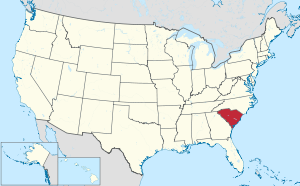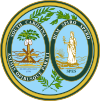Lancaster County, South Carolina
Lancaster County | |
|---|---|
U.S. county | |
 Lancaster County Original Courthouse, now a visitor's center. | |
 Location within the U.S. state of South Carolina | |
 South Carolina's location within the U.S. | |
| Coordinates: 34°41′N 80°42′W / 34.69°N 80.7°W | |
| Country | |
| State | |
| Founded | 1785 |
| Seat | Lancaster |
| Largest city | Lancaster |
| Area | |
| • Total | 555 sq mi (1,440 km2) |
| • Land | 549 sq mi (1,420 km2) |
| • Water | 6.0 sq mi (16 km2) 1.1%% |
| Population (2010) | |
| • Total | 76,652 |
| • Estimate (2020) | 100,926 |
| • Density | 140/sq mi (53/km2) |
| Time zone | UTC−5 (Eastern) |
| • Summer (DST) | UTC−4 (EDT) |
| Congressional district | 5th |
| Website | mylancastersc |
Lancaster County /ˈlæŋkəstər/[1] is a county located in the U.S. state of South Carolina. As of the 2010 census, its population was 76,652.[2] Its county seat is Lancaster, which has an urban population of 23,979.[3] The county was created in 1785.[4]
Lancaster County is included in the Charlotte-Concord-Gastonia, NC-SC Metropolitan Statistical Area. It is located in the Piedmont region.
History[]
For hundreds of years, the Catawba Indians occupied what became organized as Lancaster County as part of their historic tribal lands. The Siouan-speaking Catawba were once considered one of the most powerful Southeastern tribes. The Catawba and other Siouan peoples are believed to have emerged and coalesced as individual tribes in the Southeast. Primarily sedentary, cultivating their own crops, the Catawba were friendly toward the early European colonists.
When the first Anglo-Europeans reached this area in the early 1750s, they settled between Rum Creek and Twelve Mile Creek. Waxhaw Creek within this area was named after the Waxhaw Indian tribe that was prominent in the region. The majority of the new settlers were Scots-Irish who had migrated from Pennsylvania, where they had landed in Philadelphia. Other Scots-Irish from the backcountry of North Carolina and Virginia joined them. A significant minority of the population was German.
Many of the early settlers migrated to South Carolina from Lancaster, Lancashire in the northwest region of England. They had named their county for the House of Lancaster, which had opposed the House of York in the struggles of 1455–85, known as the War of the Roses. The House of Lancaster chose the red rose as their emblem while their neighbor, York County, boasts the white rose.
A second settlement was made in the lower part of the present Lancaster County on Hanging Rock Creek. The South Carolina colony first made a grant to settlers there in 1752; it included the overhanging mass of rock for which the creek was named. About the time the colony opened up this section, other settlers came in and settled along Lynches Creek, Little Lynches creek, Flat Creek, Beaver Creek, and lower Camp Creek. In coming to the Lancaster area, the first settlers followed old Indian paths. The increased traffic began to enlarge the paths and improve them as dirt roads.
The Rocky River Road was also based on an Indian path. During the American Revolutionary War, Colonel Abraham Buford and his forces fled from Tarleton along this road. He was overtaken a few miles south of the North Carolina state line, where the Patriot forces were defeated in the Battle of Waxhaws. Locals call it Bufords Massacre. Today, the Rocky River Road has been absorbed by part of South Carolina Highway 522, which was constructed following the old thoroughfare very closely.
Geography[]
According to the U.S. Census Bureau, the county has a total area of 555 square miles (1,440 km2), of which 549 square miles (1,420 km2) is land and 6.0 square miles (16 km2) (1.1%) is water.[5] It is bounded on the west by the Catawba River and Sugar Creek and on the east by the Lynches River.
Adjacent counties[]
- Union County, North Carolina - northeast
- Chesterfield County - east
- Kershaw County - south
- Fairfield County - southwest
- York County - west
- Chester County - west
- Mecklenburg County, North Carolina - north
Demographics[]
| Historical population | |||
|---|---|---|---|
| Census | Pop. | %± | |
| 1790 | 6,302 | — | |
| 1800 | 6,012 | −4.6% | |
| 1810 | 6,318 | 5.1% | |
| 1820 | 8,716 | 38.0% | |
| 1830 | 10,361 | 18.9% | |
| 1840 | 9,907 | −4.4% | |
| 1850 | 10,988 | 10.9% | |
| 1860 | 11,797 | 7.4% | |
| 1870 | 12,087 | 2.5% | |
| 1880 | 16,903 | 39.8% | |
| 1890 | 20,761 | 22.8% | |
| 1900 | 24,311 | 17.1% | |
| 1910 | 26,650 | 9.6% | |
| 1920 | 28,628 | 7.4% | |
| 1930 | 27,980 | −2.3% | |
| 1940 | 33,542 | 19.9% | |
| 1950 | 37,071 | 10.5% | |
| 1960 | 39,352 | 6.2% | |
| 1970 | 43,328 | 10.1% | |
| 1980 | 53,361 | 23.2% | |
| 1990 | 54,516 | 2.2% | |
| 2000 | 61,351 | 12.5% | |
| 2010 | 76,652 | 24.9% | |
| 2020 | 96,016 | 25.3% | |
2000 census[]
As of the census[6] of 2000, there were 61,351 people, 23,178 households, and 16,850 families living in the county. The population density was 112 inhabitants per square mile (43/km2). There were 24,962 housing units at an average density of 46 per square mile (18/km2). The racial makeup of the county was 71.03% White American, 26.86% African American, 0.22% Native American, 0.27% Asian American, 0.02% Pacific Islander, 0.89% from other races, and 0.71% from two or more races. 1.59% of the population were Hispanic or Latino of any race.
There were 23,178 households, out of which 33.40% had children under the age of 18 living with them, 52.60% were married couples living together, 15.50% had a female householder with no husband present, and 27.30% were non-families. 23.70% of all households were made up of individuals, and 9.40% had someone living alone who was 65 years of age or older. The average household size was 2.56 and the average family size was 3.01.
In the county, the population was spread out, with 25.40% under the age of 18, 8.60% from 18 to 24, 30.30% from 25 to 44, 23.60% from 45 to 64, and 12.10% who were 65 years of age or older. The median age was 36 years. For every 100 females there were 98.20 males. For every 100 females age 18 and over, there were 95.40 males.
The median income for a household in the county was $34,688, and the median income for a family was $40,955. Males had a median income of $30,176 versus $22,238 for females. The per capita income for the county was $16,276. About 9.70% of families and 12.80% of the population were below the poverty threshold, including 16.50% of those under age 18 and 15.80% of those age 65 or over.
2010 census[]
As of the 2010 United States Census, there were 76,652 people, 29,697 households, and 21,122 families living in the county.[7] The population density was 139.6 inhabitants per square mile (53.9/km2). There were 32,687 housing units at an average density of 59.5 per square mile (23.0/km2).[8] The racial makeup of the county was 71.5% white, 23.8% black or African American, 0.6% Asian, 0.3% American Indian, 2.4% from other races, and 1.3% from two or more races. Those of Hispanic or Latino origin made up 4.4% of the population.[7] In terms of ancestry, 23.9% were American, 8.0% were Irish, 7.6% were English, and 7.2% were German.[9]
Of the 29,697 households, 33.2% had children under the age of 18 living with them, 51.0% were married couples living together, 15.4% had a female householder with no husband present, 28.9% were non-families, and 24.7% of all households were made up of individuals. The average household size was 2.51 and the average family size was 2.97. The median age was 39.7 years.[7]
The median income for a household in the county was $38,959 and the median income for a family was $46,388. Males had a median income of $39,681 versus $28,985 for females. The per capita income for the county was $19,308. About 15.8% of families and 20.4% of the population were below the poverty line, including 30.2% of those under age 18 and 11.2% of those age 65 or over.[10]
Communities[]
City[]
- Lancaster (county seat)
Towns[]
Census-designated places[]
- Buford
- Elgin
- Irwin
- Lancaster Mill (former CDP)
- Springdale
- Tradesville
- Unity
Other unincorporated communities[]
Politics[]
Notable residents/natives[]
This section needs additional citations for verification. (October 2012) |
- Bill Belk, professional football player (San Francisco 49ers)
- Sheldon Brown, professional football player
- Wayne A. Cauthen, first appointed African-American City Manager, Kansas City, MO
- Danny Clyburn, professional baseball player (Baltimore Orioles, Tampa Bay Devil Rays, Pittsburgh Pirates)
- Shawn Crawford, sprinter and Olympic gold medalist
- Don Dixon, record producer, songwriter, musician
- Charles Duke, astronaut and moon-walker
- James "Butch" Duncan, Professional NFL Baltimore Colts player Super Bowl V
- Pep Harris, professional baseball player (Cleveland Indians, Anaheim Angels)
- Jim Hodges, former Governor of South Carolina
- Andrew Jackson, seventh President of the United States[12]
- Nina Mae McKinney, actress and Broadway star
- Todd Ray, aka 'T-Ray', Grammy Award-winning record producer
- Julie Roberts, country music singer
- Aaron Robinson, Major League Baseball player (New York Yankees, Detroit Tigers, Chicago White Sox, Boston Red Sox)
- Darrell Shropshire, professional football player
- Nelson Sullivan, video artist and 1980s Club Kids personality.
- J. Marion Sims, surgeon known as the "Father of Modern Gynecology"
- The Zodiacs, led by Maurice Williams, R&B vocal group
- Jeff Twitty, professional baseball player (Kansas City Royals)
- Brian Williams, professional baseball player (Houston Astros, Detroit Tigers, Baltimore Orioles, Chicago Cubs, Boston Red Sox)
See also[]
References[]
- ^ "Parlez-Vous Palmetto? The SC Pronunciation Guide ..." SCIWAY. Retrieved 5 September 2019.
- ^ "State & County QuickFacts". United States Census Bureau. Archived from the original on June 6, 2011. Retrieved November 25, 2013.
- ^ "Find a County". National Association of Counties. Retrieved 2011-06-07.
- ^ "South Carolina: Individual County Chronologies". South Carolina Atlas of Historical County Boundaries. The Newberry Library. 2009. Archived from the original on January 3, 2017. Retrieved March 21, 2015.
- ^ "2010 Census Gazetteer Files". United States Census Bureau. August 22, 2012. Retrieved March 18, 2015.
- ^ "U.S. Census website". United States Census Bureau. Retrieved 2011-05-14.
- ^ Jump up to: a b c "DP-1 Profile of General Population and Housing Characteristics: 2010 Demographic Profile Data". United States Census Bureau. Archived from the original on 2020-02-13. Retrieved 2016-03-11.
- ^ "Population, Housing Units, Area, and Density: 2010 - County". United States Census Bureau. Archived from the original on 2020-02-13. Retrieved 2016-03-11.
- ^ "DP02 SELECTED SOCIAL CHARACTERISTICS IN THE UNITED STATES – 2006-2010 American Community Survey 5-Year Estimates". United States Census Bureau. Archived from the original on 2020-02-13. Retrieved 2016-03-11.
- ^ "DP03 SELECTED ECONOMIC CHARACTERISTICS – 2006-2010 American Community Survey 5-Year Estimates". United States Census Bureau. Archived from the original on 2020-02-13. Retrieved 2016-03-11.
- ^ Leip, David. "Dave Leip's Atlas of U.S. Presidential Elections". uselectionatlas.org. Retrieved 2018-03-13.
- ^ Born in the Waxhaw region on the North Carolina–South Carolina border. Exactly on which side of the border Jackson was born is in dispute. Jackson himself considered South Carolina as his birth state, and that is how it is most frequently listed. https://www.washingtonpost.com/wp-dyn/content/article/2011/03/06/AR2011030603406.html?wprss=rss_print/asection
External links[]
| Wikimedia Commons has media related to Lancaster County, South Carolina. |
- South Carolina counties
- Lancaster County, South Carolina
- 1785 establishments in South Carolina
- Populated places established in 1785





